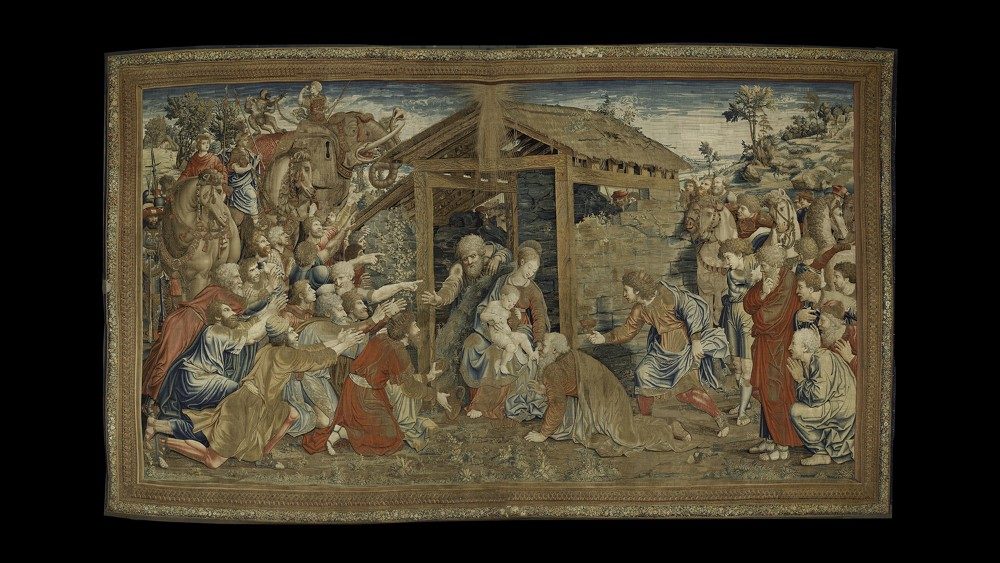Christmas at the Vatican Museums
By Paolo Ondarza
The first representations of the Nativity of Jesus precede the living Nativity scene staged exactly 800 years ago, on Christmas 1223, by Saint Francis of Assisi in Greccio in the Rieti Valley. The first Christians, in fact, celebrated the Incarnation of Our Lord. One of the earliest nativity scenes ever, dating back to a sarcophagus from the 4th century and preserved at the Vatican Museums, bears witness to this: on the stone are carved the figures of the Child in the manger, the ox, the star, and the Virgin Mary.
A visit for everyone
Sister Emanuela Edwards, in charge of Educational Activities for the pontifical collections, illustrates the archaeological artifact preserved at the Pius-Christian Museum. She provides a preview of the special tour that the Pope's museums dedicate to Christmas for the second consecutive year, exclusively on the Saturdays preceding Christmas day. It’s an initiative for everyone, no one excluded: families with children, tourists, pilgrims, and individuals with sensory, motor, and intellectual disabilities.
An experience of evangelization
The special Christmas tours started last year and received very positive feedback, Sr Emanuela explains, adding that most visitors said they found the tour greatly helpful in preparing for Holy Christmas.
“What particularly moved me was the reaction of children who enthusiastically learned about the origins of the characters in the nativity scene. For some of them, it was the first time they encountered the biblical stories of the birth of Jesus. The tour was truly an act of evangelization!" she said.
The birth, the shadow of the cross, and Redemption
The visit, in Italian or English, recounts the various ways in which the nativity scene has been represented over the centuries. In addition to early Christian art, ample space is dedicated to masterpieces in the Vatican Art Gallery. Among them, attention is captured by the preciousness and uniqueness of the 14th-century "Adoration of the Shepherds" by Bartolo di Fredi: in this work, Sister Emanuela Edwards observes, "the Lord is not laid in a manger but in a sarcophagus wrapped in a shroud. The Madonna is dressed in black as if in mourning. The scene represents the shadow of the cross because our Lord was born to die for the Redemption of the world. In this interesting work, there is joy tinged with sadness. We are called to meditate on the fact that this child has a mission, and the heavens, represented by the angels, rejoice at this event."
The light of the world
The visit continues in the splendid Gallery of Tapestries, where another Adoration of the Shepherds is depicted on a precious cloth. It is from the School of Raphael, and the tapestry was made in the workshop of the Flemish weaver Pieter Von Alst of Brussels in the 16th century. The scene is intimate, familiar: "Saint Joseph," notes the head of the Educational Activities Office of the Vatican Museums, "indicates the Christ child to his humble visitors. The shepherds, for their part, bring their simple gifts to the child. The light of Christ illuminates the entire stable: He is the source of light in the scene because, as we read in the Gospel of Saint John, He is the light of the world."
Living pages of Scripture
The tour, in a crescendo of beauty culminating in the Sistine Chapel, helps us enter into the mystery of Christmas, in which God became flesh in the most beautiful of human sons. "Saint Francis, many centuries ago," recalls the nun, "used a 'real' or artistic manifestation of the first Christmas to help us understand the reality of the birth of Christ. Since then, artists have tried to bring us to the manger so that we can reflect on the Gospel as we contemplate it before our eyes in their masterpieces. These works thus become living pages of Scripture, helping us meditate on the story of the birth of the Lord."
Participants, not spectators, of Christmas
What Sister Emanuela Edwards tells us is indeed true: by contemplating the art of the Vatican Museums, we too become participants, not just spectators, of the mystery of the Incarnation, and we can ask ourselves, "What would we have done in the place of the shepherds... of the kings?" "In proposing this visit, I am motivated by the opportunity to contribute to announcing the wonder of the Lord's coming to the visitors of the Museums so that, this Christmas, they too can be touched by the Child of Bethlehem. Furthermore, we celebrate this feast to give glory to God, thanking Him for the gift of Christ to the entire world. "Through art," she concludes, "the events of the Lord's birth enter into our minds and hearts in a real way, contributing to making this central mystery not only for faith but also for our lives."
Thank you for reading our article. You can keep up-to-date by subscribing to our daily newsletter. Just click here



















